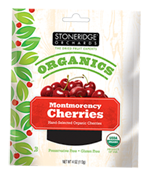Nature����s Candy: Yes, it����s Actually Good for You
 If you grew up in America, your mother told you at least once when you were a kid – “Fruit is nature’s candy.” And if she said it before she gave you some cherries, you agreed right away.
If you grew up in America, your mother told you at least once when you were a kid – “Fruit is nature’s candy.” And if she said it before she gave you some cherries, you agreed right away.
If she said it while handing you an apple after you begged for a candy bar after school, you may have taken some convincing.
Fruit is the original “natural” source of sugar. And just like mom always said about fruits and vegetables: it’s good for you. Much more so than man-made candy. (Turns out Mom was right about this and many things).
True, fruit does contain fructose, the naturally occurring sugar. Fructose is found in tree and vine fruits and berries (and most root vegetables). Generally, the sweeter the fruit tastes, the more sugar it contains.
Sweet is one of the tastes humans are programmed to seek out in foods. Which is why we’ve been eating fruit – nature’s candy – since our hunter-gatherer days. Our brains recognize sweet foods as highly caloric. (Want to know why humans love to eat sweet things, and our long history with sugar? Check out “The Science of Sweet” on the SciShow Channel on YouTube at http://youtu.be/qQarsq-1ykE .)
In addition to natural sugar, fruits also contain much-needed fiber, essential vitamins, flavonoids and antioxidants. (Flavonoids are compounds found in fruits, vegetables, and some grains that, if not over-consumed, benefit human health. Antioxidants are compounds that help the human body repair damage done to its cells; research also links antioxidant consumption to healthy hearts and health in general.)
Different fruits contain varying levels of sugar, flavonoids and antioxidants. Flavonoids give fruit its color. Generally, the more vibrant the color of the fruit, the more flavonoids it contains.
And when it comes to color, red and blue fruits pack a powerful fruit punch full of good stuff.
Both are colored by natural plant pigments called anthocyanins – among the most powerful antioxidants. Raspberries, strawberries and blueberries full of them. Some studies have linked anthocyanins in raspberries and strawberries with cell-repairing powers and heart health. Other studies have shown that eating more blueberries is associated with improved memory function and healthy aging. (See “What Color is Your Food?” North Dakota State University, http://www.ag.ndsu.edu/pubs/yf/foods/fn595.pdf).
Cherries, another raucously red fruit, are also full of flavonoids and antioxidants. In fact, cherries and aspirin contain the same natural anti-inflammatory compounds. Tart cherries may contain the most concentrated amounts of anti-inflammatory compounds on the planet, according to some recent research. They’re also gaining scientific notice for cutting post-exercise pain in athletes and helping fat rats lose weight. (See this 2012 Los Angeles Times article on Cherry Pie -- or at least the cherries in it -- being good for you: http://www.latimes.com/health/la-he-sour-cherry-20120714,0,4603452.story)
Despite generations of moms and two or three decades of scientific studies pointing out what’s good for you, Americans still don’t eat enough fruits and vegetables.
Remember the “Five a Day” campaign – five servings of fruits and vegetables a day? Even in the healthiest states, the median daily fruit and veggie serving numbers still haven’t crawled above 1.8. (Which are the healthiest states when it comes to eating fruits and vegetables? Check this FastFacts map here: http://www.fastcoexist.com/1682262/mapping-where-americans-eat-the-most-fruits-and-vegetables).
One way to keep up your daily fruit intake year-round is to include dried fruits -- prized since ancient times for their extended “shelf life,” portability and sweetness.
When made with care, dried fruit is just fresh fruit with the water removed – either by the sun, or low heat over or in hearths and ovens. The drying process leaves just enough moisture for fruits to be mouth-pleasing, yet naturally resist spoiling. Careful creation during the drying process leaves the fiber and nutrition intact and also concentrates its sugar. Most fruits shrink dramatically during the drying process, intensifying flavor and sweetness into a smaller package.
Some recent studies have suggested that dried fruits may help people trying to lose weight by making them feel “fuller” longer. Other studies are finding that antioxidants in cranberries, among others, are more potent than those in their fresh counterparts.
(For more, see this article in Real Simple magazine at http://www.realsimple.com/food-recipes/shopping-storing/food/healthy-dried-fruit-00000000055378/index.html.)
Some fruits, like cranberries, are sweetened during the drying process because without additional sugars, they’d be too tart to eat. Check the labels on dried fruit packaging – and all packaged items – before purchasing to see what ingredients went into the food inside.
And it wouldn’t hurt to call your mother and tell her that she was right about fruit being nature’s candy. She’d appreciate it.

